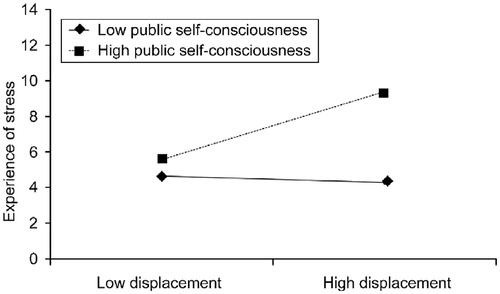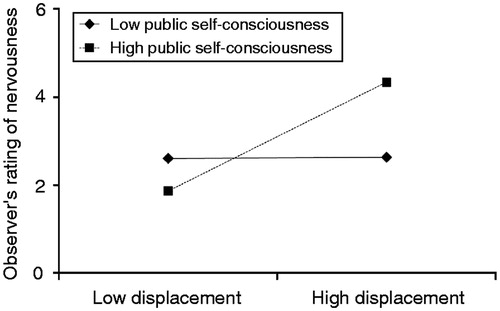Figures & data
Table 1. Ethogram of the displacement behaviours recorded in this study.
Table 2. Bivariate correlations of public self-consciousness, displacement behaviour, measures of stress and ratings of participants' nervousness.
Figure 1. Experience of stress during the TSST as a function of displacement behaviour and public self-consciousness. Low displacement behaviour/public self-consciousness was defined as below the mean − 1 SD; high was defined as above the mean + 1 SD. This figure displays the variation of experience of stress within the range of displacement behaviour and public self-consciousness using the test of simple slopes. The t-test results in conjunction with Bonferroni correction using median-split displacement behaviour and public self-consciousness revealed that the women high in both displacement behaviour and public self-consciousness (n = 15) reported significantly higher levels of stress than women low in displacement behaviour and high in public self-consciousness (n = 22); t(35) = 4.53, p < 0.001. Furthermore, women high in both displacement behaviour and public self-consciousness (n = 15) reported higher levels of stress than women high in displacement behaviour and low in public self-consciousness (n = 16); t(29) = 9.02, p < 0.001.

Table 3. Testing standardized moderator effects of public self-consciousness using a hierarchical multiple regression (n = 62).
Figure 2. Number of mistakes in mental arithmetic task during the TSST as a function of displacement behaviour and public self-consciousness. Low displacement behaviour/public self-consciousness was defined as below the mean − 1 SD; high was defined as above the mean + 1 SD. This figure displays the variation in the number of mistakes in the cognitive task within the range of displacement behaviour and public self-consciousness, using the test of simple slopes. The t-test results in conjunction with Bonferroni correction using median-split displacement behaviour and public self-consciousness revealed that the women high in both displacement behaviour and public self-consciousness (n = 15) made significantly more mistakes in the cognitive task than women low in displacement behaviour and high in public self-consciousness (n = 22); t(35) = 3.12, p < 0.01. Furthermore, women high in both displacement behaviour and public self-consciousness (n = 15) made significantly more mistakes than women high in displacement behaviour and low in public self-consciousness (n = 16); t(29) = 6.82, p < 0.001. In addition, women low in displacement behaviour and low in public self-consciousness (n = 9) made significantly more mistakes in the cognitive task than women high in displacement behaviour and low in public self-consciousness (n = 16); t(23) = 5.85, p < 0.001.

Figure 3. Observer's rating of nervousness of participants during the TSST as a function of displacement behaviour and public self-consciousness. Low displacement behaviour/public self-consciousness was defined as below the mean − 1 SD; high was defined as above the mean + 1 SD. This figure displays the variation in observers' rating of nervousness within the range of displacement behaviour and public self-consciousness, using the test of simple slopes. The t-test results in conjunction with Bonferroni correction using median-split displacement behaviour and public self-consciousness revealed that women high in both displacement behaviour and public self-consciousness (n = 15) were rated as more nervous than women low in displacement behaviour and high in public self-consciousness (n = 22); t(35) = 3.50, p < 0.01.
